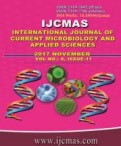


 National Academy of Agricultural Sciences (NAAS)
National Academy of Agricultural Sciences (NAAS)

|
PRINT ISSN : 2319-7692
Online ISSN : 2319-7706 Issues : 12 per year Publisher : Excellent Publishers Email : editorijcmas@gmail.com / submit@ijcmas.com Editor-in-chief: Dr.M.Prakash Index Copernicus ICV 2018: 95.39 NAAS RATING 2020: 5.38 |
Blood stream infections are very common in paediatric age group and are one of the common causes of morbidity and mortality. Septicaemia gradually leads to serious consequences like shock, multi organ failure, DIC etc. Timely identification of causative pathogen by blood culture (gold standard) is important. Antibiogram also helps us to elevate consciousness on resistance problems and recognise prospect to decrease the use of inappropriate antibiotics. The study was undertaken to evaluate major bacterial isolates causing septicaemia and their antibiogram pattern. The present study was carried out on 252 clinically diagnosed septicaemia cases. The growth was identified by conventional biochemical tests. Antibiotic susceptibility test was done by modified Kirby – Bauer method. Drug resistant strains in primary screening were further processed for the detection of ESBL and MRSA strains. Bacteremia was more prevalent in ≤ 28 days children which was stastistically significant. Majority of the female children showed significant bacteremia compare to male children. K pneumonia was more prevalent, C. fruendii and S. typhi were the least prevalent bacteria. 50% of S aureus were MRSA which is matter of concern. Sepsis is a medical emergency which requires timely detection and identification of blood borne pathogens with urgent rational antibiotic therapy. Infants and children are the vulnerable population to contract illness because of their weak immune barrier. Antibiotic sensitivity pattern to common pathogens has been changing from day to day and it is important to have latest information for guiding local empirical choice of antibiotics.
 |
 |
 |
 |
 |